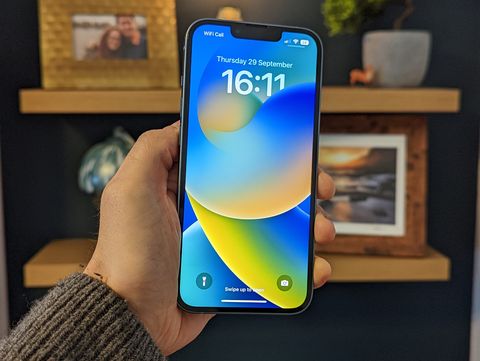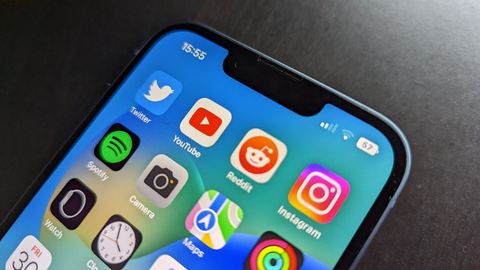Another year, another iPhone. That’s right, Apple’s latest batch of smartphones are hitting shelves – but whether you have an iPhone 13 in your pocket or are considering ditching your Android phone in favour of iOS, there’s one big question that’s probably on your mind, is it worth buying the new one?
The standard iPhone 14 promises upgrades to the front and back cameras, a “crash detection” safety feature, slightly more memory and a new “action mode” for videos to reduce shakiness. But the rest – including the display, screen, processor, water resistance and storage – is the same.
With the iPhone 13 still widely available for £100 less, there’s a good chance that you’re wondering if you really need the iPhone 14. Perhaps you should go after an older or refurbished model, or even hold off until next year. So, let’s break down how the two Apple smartphones compare in more detail.
Is there a big difference between iPhone 13 and 14?
The quick answer to this question is no. There isn’t a big difference to note here. This year’s iPhone 14 and last year’s model have a lot in common, coming in the same size, with the same display, the same processor and almost identical camera systems. We do think there are some reasons to go for the newer 14, because it has a couple of photo and video upgrades, marginally more battery life, along with the aforementioned car crash detection for safety.
Here are the main specifications at a glance, and what remains unchanged:
- Screen size: 6.1 inches (the same on both the 13 and 14)
- Resolution: 2532 x 1170 pixels (the same on both the 13 and 14)
- Processor: Apple A15 Bionic (the same on both the 13 and 14)
- Cameras: Two rear cameras – 12MP wide-angle and 12MP ultra-wide angle – and a 12MP wide front camera (the same on both the 13 and 14, although with some small upgrades)
- Battery life: 19 hours of video playback on the 13, and 20 hours of video playback on the 14
- Storage: 128GB, 256GB, 512GB (the same options on both the 13 and 14)
- MicroSD card slot: No (the same on both the 13 and 14)
- Weight: 174g for the 13, 172g for the 14
Is iPhone 13 the same size as iPhone 14?
The 6.1-inch screen size of both phones is exactly the same, however the frame of the new model is just slightly thicker which, unfortunately, means that cases for the iPhone 13 can’t be re-used on the iPhone 14. The design hasn’t been updated so you get the same build quality, button layout and notch on both phones, too. Unlike the previous two generations, there’s no new version of the iPhone mini this year, with Apple instead offering a larger option, the 6.7-inch iPhone 14 Plus.
What’s the difference between the iPhone 13 and iPhone 14 cameras?
If you put pictures taken from these cameras side-by-side, especially if you’re looking at them on your Facebook feed or Instagram story, you’re not going to notice the difference. That isn’t because there aren’t some changes with the new iPhone 14, just that they’re somewhat minor compared to the big leaps we can see in the iPhone 14 Pro. It’s a shame that the iPhone 14 still has just two lenses on the back – a wide and an ultra-wide – compared to other more affordable smartphones like the Samsung Galaxy A53 5G or Google Pixel 6 that come with a useful zoom lens on the back, so you can get closer to your subject without moving your feet.
Which iPhone is best for selfies? That’ll be the new 14, which has an upgraded front camera with a wider aperture, stabilisation and autofocus. This means it gathers more light and focuses on your face reliably. In short, that gets you better selfies, improved FaceTime calls and better video from the front lens.
On the back, there’s another slight enhancement. The main rear camera on the latest iPhone 14 now has a faster aperture and larger sensor size, essentially making this lens match last year’s iPhone 13 Pro. Photos from the iPhone 14 are better, but it may be hard for most people to tell.
What about video? The new “action mode” on the 14 is a welcome addition that stabilises judder and shakes when you’re walking or running around. It's ideal for taking videos of kids who can’t stay still or if you’re chasing your dog around the house and trying to capture it on camera. This feature isn’t on the older iPhone 13 models, so we think it’s a good selling point for the new one. On test, it worked great.
Below, we've included a gallery of photos we've taken on both the iPhone 14 and iPhone 13, to show that it's hard to see the difference between them:
Does the iPhone 14 cost the same as the iPhone 13?
Despite not seeing too many major changes to the design or specs this year, Apple has upped the asking price of the iPhone 14 in the UK, adding £100 to the entry-level 128GB model. That iPhone 14 starts at £849, with a 256GB option at £959 and a 512GB at £1,179. For comparison, the iPhone 13 released in the UK started from £779, with a 256GB version at £879 and a 512GB model at £1,079.
New for this year, the 6.7-inch iPhone 14 Plus starts at £949, the iPhone 14 Pro starts at £1,099, and the iPhone Pro Max – which is the most powerful of the new bunch – starts at £1,199. There’s no longer a mini option, but you can buy a more affordable iPhone SE, with an older design, for under £500.
Is the iPhone 14 faster than the iPhone 13?
The iPhone 14 uses Apple’s A15 Bionic chip – that’s the same highly impressive processor as last year’s iPhone 13 Pro. Performance-wise, you won’t see or feel a difference between the two handsets. While it definitely caught our attention that the new model didn’t feature the same A16 Bionic chip that’s in the Pro models this year, on test we had no concerns about the performance, speed or efficiency of the 14. Apps download fast and run without issues, and navigating around the menus is silky smooth. Sure, it seems like an issue on paper, but in reality, last year’s processor is still excellent.
What colours are available?
The colour options have been slightly refreshed this year, with the iPhone 14 coming in midnight (black), blue, purple, starlight (white) and red. We tested a blue model and it looks fantastic – easily standing out from the black or grey phone shades you’ll often see people holding. For comparison, the iPhone 13 is available in six hues: green, dark blue, pink, midnight (black), starlight (white) and red.
Is the iPhone 14 worth it compared to the iPhone 13?
We spent about a week using the iPhone 14 to test how it compares to the previous model and other handsets in its price range, finding almost every aspect of the phone is fantastic, although very little has been updated since last year’s iPhone 13 and it’s a shame that the new base model doesn’t get the new A16 chip, higher refresh rate or the “Dynamic Island” tech of the iPhone 14 Pro models.
The cameras, screen and iOS 16 software on the new are all a joy to use, and the build quality feels very high-end, but the same goes for its recent predecessors. The iPhone 13 is still widely available from £749, and the iPhone 12 is still available from £649. Older models are available refurbished on BackMarket too, and we highly recommend giving tech a second life. If budget is your top priority, you can also pick up the new iPhone SE for £449.
But that’s not to say the iPhone 14 doesn’t have its charms. Anyone who wants the latest-and-greatest tech will find a lot to love, as will anyone who is moving over from an Android smartphone but doesn’t want to pay the £1,000+ for a Pro model. It’s also possible the iPhone 14 could see some very tempting contract deals. For us, the iPhone 14 is a top flagship, even if it’s not a completely must-have one.
Should you buy a refurbished iPhone?
Phones are expensive and times are tough – we totally get it. If you want to keep the costs down you may want to consider buying a refurbished model via a website like BackMarket, which is listing the still-impressive iPhone 11 in excellent condition for around £320 and the 2020 iPhone SE for just under £170. The site checks over each phone that it lists, gives you 30 days to change your mind and you get a full year’s warranty protecting against faults. It’s a great option if you’re tightening the belt. We’ve got experience buying refurbished tech, whether that’s laptops or smartwatches, and we’ve never had an issue.
Websites that sell refurbished models usually grade the handsets based on their appearance. In the case of BackMarket, the ratings go from Fair – small scratches or marks – to Excellent, where the screen is in a near-perfect condition. Another popular option, Amazon Renewed, grades from Acceptable – visible scratches or marks – to Excellent, which is a phone that shows no signs of cosmetic issues from 30 centimetres away. Each platform usually has its own grading system, so always double-check that you’re buying, and make sure there’s a warranty included.
What about the iPhone 14 Pro and 14 Pro Max?
If you need more power and features, you’ll want to consider the “Pro” handsets in the new lineup, the iPhone 14 Pro (from £1,099) and the iPhone 14 Pro Max (from £1,199). Both have an extra 48MP main camera with a better zoom, plus the new “Dynamic Island” technology that lets iOS apps use the new pill-shaped notch on the front to show status alerts and notifications. On test, we were impressed by how seamless it works, and now we can’t imagine not having it.
On the two Pro models, you also get a better battery life (up to 29 hours on the Pro Max compared to up to 20 hours of the standard iPhone 14) and it comes with the latest A16 chip that keeps performance silky smooth. For the first time, Apple brought in an always-on display, too. They are expensive flagships, but we reckon they’re worth it if you’ll be taking lots of photos or need more storage – the 14 Pro models both have the option of up to 1TB of built-in space.
https://news.google.com/__i/rss/rd/articles/CBMiWmh0dHBzOi8vd3d3Lmdvb2Rob3VzZWtlZXBpbmcuY29tL3VrL3Byb2R1Y3QtcmV2aWV3cy90ZWNoL2E0MTQ2MjU4My9pcGhvbmUtMTQtdnMtaXBob25lLTEzL9IBAA?oc=5
2022-09-30 16:02:07Z
1579823553




Tidak ada komentar:
Posting Komentar